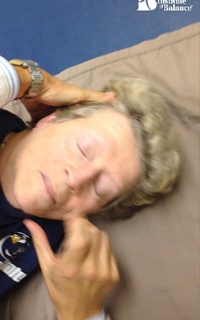
VIDEO – VPPB-CP Nistagmos: Observación del Ojo Contralateral
Published on: diciembre 17, 2013
En este video, el paciente es acostado sobre el lado izquierdo – Hallpike modificado con el oído izquierdo para abajo. Se observa claramente en el, un nistagmos torsional que batea para arriba (el componente vertical es más fuerte que el torsional como se observa comúnmente) asociado con el oído izquierdo CP -VPPB. Cuando se observa por nistagmos de VPPB , independientemente de que la observación sea directa o con VOG / VNG, es útil observar el ojo contralateral (en este video, es el ojo derecho). El RVO (Reflejo Vestíbulo-Ocular) es cruzado (véase el diagrama adjunto) y el nistagmos más fuerte y claro se verá en el ojo opuesto al oído en prueba / tratado. Para los pacientes con párpados pesados /caídos o aquellos que no se atreven a mantener los ojos abiertos (la visión aumenta la alucinación de vértigo), es fácil levantar el párpado del ojo contralateral para visualizar fácilmente el nistagmos. Esto no es incómodo para el paciente y será muy útil, especialmente para los médicos sin VOG / VNG que no pueden reproducir una grabación del nistagmos.

Referencias:
Gans RE, Vestibular Rehabilitation in Textbook of Vertigo: Diagnosis and Treatment, F. Dispenza and A. DeStefano (Eds.), Jaypee Medical Publishing, 2013
Robert RA and Gans RE, Nonmedical Management of Positional Vertigo, in Balance Function Assessment and Management,Jacobson GP and Shepard NT, Plural Publishing, 2008

Recent Posts
Comparison between Epley and Gans Repositioning Maneuvers for Posterior Canal BPPV: A Randomized Controlled Trial
Published on: marzo 26, 2024
Annals of Indian Academy of Neurology | Volume 26 – Issue 4 – July-August 2023 Benign paroxysmal positional vertigo (BPPV) is one of the commonly occurring causes of vertigo. BPPV […]
Read more
How to evaluate and treat the dizzy patient: non-medical diagnosis-based strategies
Published on: febrero 16, 2024
ENT & Audiology News | Balance & Vestibular Disorders 2024 It is estimated that dizziness, vertigo and falls are the third most common complaints heard by physicians from all age […]
Read more
The cost of untreated vestibular conditions: the role of otolaryngology & rehabilitation
Published on: febrero 15, 2024
Journal of Otolaryngology-ENT Research | Volume 16 Issue 1 – 2024 It is estimated that dizziness, vertigo, and falls are the third most common complaints heard by physicians from all […]
Read more
Understanding Mal de Debarquement syndrome (MdDS), persistent postural perceptual dizziness (3PD) and somatoform disorders: and the role of vestibular rehabilitation therapy (VRT)
Published on: enero 3, 2024
Volume 16 Issue 1 – 2024 Richard E Gans, Kimberly Rutherford, Allisson D’Alessandro American Institute of Balance, USA Correspondence: Richard E Gans, Founder and Executive Director of the American Institute […]
Read more


